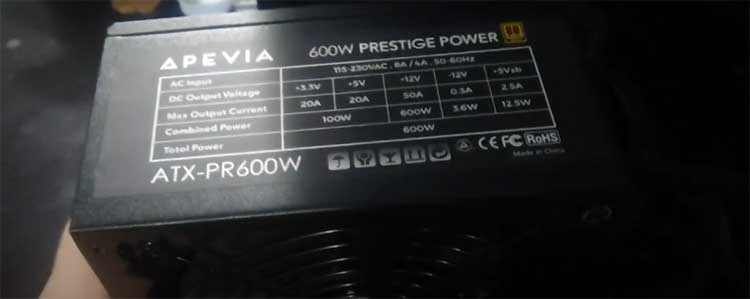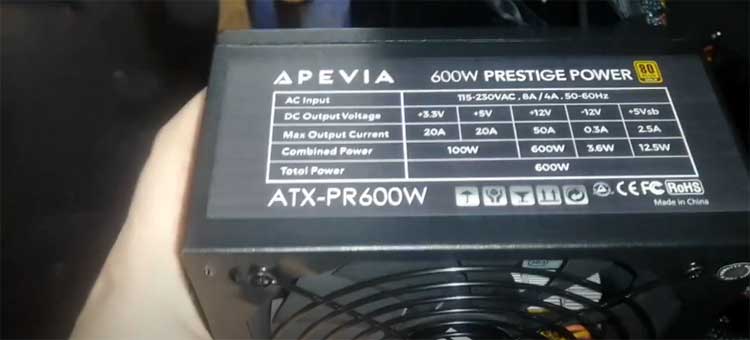When you’re in the market for a reliable power supply that balances performance with affordability, you can’t overlook the Apevia ATX-PR600W Prestige 600W power supply. I’ve used it in several builds, and let me tell you—it delivers where it counts.
Whether you’re putting together your first gaming rig or upgrading your current setup, this PSU offers great value, decent efficiency, and stability. If you’re asking me, it’s an option you should seriously consider.
Let’s break down why this might be the right choice for you and how it stacks up against the competition.
My Experience With Apevia Power Supply

When I first decided to use the Apevia ATX-PR600W Prestige 600W power supply, I was initially skeptical. Apevia wasn’t a brand I was too familiar with, especially when it came to power supplies.
But as someone who’s always on the lookout for good deals without sacrificing performance, the 80 Plus Gold certification caught my eye, especially at this price point. So, I figured, why not give it a shot?
Installing it in my system was fairly straightforward, though I did find the cables a bit stiff, which made cable management a little tricky in my mid-tower case.
However, once everything was hooked up, I was impressed by how quiet the unit ran. Even during extended gaming sessions and video editing tasks, the fan noise was barely noticeable, which is a big win for me as I can’t stand loud PSU fans.
I paired it with a Ryzen 5 processor and an RX 580 GPU, and the power supply handled the load without any hiccups. The 600W capacity gave me enough headroom to confidently run my system without worrying about power shortages or instability.
After several months of use, it’s been rock solid, providing stable power without overheating or causing any system crashes.
One thing I really appreciate is its energy efficiency. I noticed a slight drop in my energy consumption compared to my previous PSU, and knowing it’s 80 Plus Gold certified gave me some peace of mind. For the price, I couldn’t be happier. It’s reliable, quiet, and efficient—everything I need in a power supply. Would I recommend it? Definitely!
Pros of Apevia Power Supply

- Affordable and efficient: The 80 Plus Gold certification means it’s energy efficient, which is rare at this price range. This keeps your electricity bills down and reduces excess heat.
- Silent operation: Even when I stressed the system with heavy gaming and rendering, the fan stayed relatively quiet. In fact, I barely noticed it.
- Reliable performance: I’ve used this power supply across multiple builds, and it has consistently performed well. I even recommended it to a few friends who’ve reported no issues.
Cons of Apevia Power Supply
- Cables are a bit stiff: The sleeved cables are durable, but they’re not as flexible as I would like. Managing them during installation can be a bit tricky, especially in smaller cases.
- Non-modular design: This means you can’t disconnect the cables you don’t need, which can clutter up your case. It’s not a dealbreaker, but it’s worth noting if you’re particular about cable management.
Now, I’m not saying it’s the best power supply out there, but for the price, it’s hard to beat. You get decent wattage, good efficiency, and quiet operation—all things I value in my builds.
How Does It Stack Up Against Other Brands?
Comparing Apevia to big names like Corsair or EVGA may feel like comparing apples to oranges, but it’s worth noting that the Apevia ATX-PR600W holds its own in many areas.
- Apevia ATX-PR600W Vs. Corsair CX650M
Corsair is a go-to brand for many builders, and for good reason. Their CX650M is modular, meaning you only connect the cables you need, which makes cable management a breeze.
However, the Apevia comes out ahead on price. While the Corsair may offer a slightly higher wattage and modularity, the Apevia wins with its lower cost and similar 80 Plus Gold efficiency rating.
If you’re looking for something that’s budget-friendly and doesn’t need fancy features, Apevia is a great pick.
- Apevia ATX-PR600W Vs. EVGA 600W
The EVGA 600W is another popular choice in the same price bracket, and while it has a similar wattage rating, I found the Apevia to be quieter during operation.
The EVGA unit also lacks the 80 Plus Gold certification, which means it’s not quite as energy efficient as the Apevia. Over time, that difference in efficiency could add up, especially if you’re using your PC for long gaming sessions or content creation.
In short, while brands like Corsair and EVGA may have some extra bells and whistles, the Apevia ATX-PR600W is an excellent option if you’re focused on getting the most bang for your buck without sacrificing too much in terms of quality.
Maintenance Tips To Prolong The Life of Your Apevia PSU
Now, one thing I’ve learned over the years is that power supplies need love, too. Here are a few tips I follow to keep my PSUs running smoothly:
- Keep it clean: Dust is the silent killer of electronics, and your PSU is no exception. Every few months, take some compressed air and blow out any dust that’s accumulated in the vents. This helps maintain airflow and prevents overheating.
- Check your connections: Make sure all the cables are seated properly, especially after moving your PC or upgrading components. Loose connections can cause power surges or make your system unstable.
- Monitor the fan: While the fan on the Apevia ATX-PR600W is quiet, you’ll want to ensure it’s spinning properly. If it stops working, the PSU could overheat and potentially fail.
- Don’t overload it: While the 600W rating should be enough for most mid-range systems, if you’re planning to upgrade to more power-hungry components—like a higher-end GPU—be mindful of the power draw. Overloading your PSU can reduce its lifespan.
- Unplug during storms: This is a simple but often overlooked tip. If there’s a thunderstorm or power outage in your area, unplug your PC. Sudden power surges can wreak havoc on your PSU and other components.
By following these simple maintenance tips, you can keep your Apevia ATX-PR600W running smoothly for years to come.
Common Issues And How To Fix Them
- Issue 1: The PSU won’t power on
If your system isn’t powering on, double-check the connections. The Apevia PSU requires all the cables to be plugged in correctly, or it simply won’t start. Make sure the 24-pin motherboard connector is securely in place, and if necessary, split the 8-pin CPU connector as per your motherboard’s requirements.
- Issue 2: PSU is overheating
If you notice the PSU getting unusually warm, it might be a dust buildup or a failing fan. First, clean out the dust with compressed air. If the fan still isn’t working, it may be time to replace the unit.
- Issue 3: Loud fan noise
While the fan is usually quiet, some users report increased noise over time. If this happens, check the fan for obstructions or debris. Sometimes a simple cleaning can fix the issue, but if the noise persists, the fan bearings might be wearing out.
Frequently Asked Questions (FAQ)
Absolutely! The Apevia Spirit 600W offers great value for the price. It provides reliable power, is 80 Plus Gold certified for energy efficiency, and has enough wattage to handle mid-range builds with ease. I’ve used this PSU in multiple setups, and it has consistently performed well without any major issues.
The best power supply rating for most people is 80 Plus Gold, which strikes a good balance between efficiency and cost. It ensures that your power supply converts at least 87% of the power it draws into usable energy, reducing waste heat and lowering your electricity bill. The Apevia ATX-PR600W falls into this category, making it a solid choice for anyone looking for efficient performance on a budget.
The RX 580 typically requires a power supply of at least 500W, but having a bit more headroom is always a good idea. The Apevia ATX-PR600W’s 600W output is more than enough to power the RX 580 along with the rest of your system components, giving you some extra cushion for future upgrades.
Wrapping Up
When it comes to power supplies, the Apevia ATX-PR600W Prestige 600W 80 Plus Gold offers solid performance at an unbeatable price. Whether you’re building your first gaming PC or upgrading an older system, it’s a reliable option that won’t break the bank.
From its energy efficiency to its quiet operation, this power supply gets the job done.
After using it in multiple builds, I can confidently say that it’s a great choice for anyone looking to power a mid-tier system without any headaches. So, if you’re in the market for a new PSU, I highly recommend giving this one a shot—you won’t be disappointed.